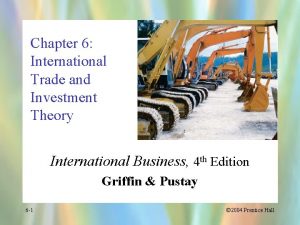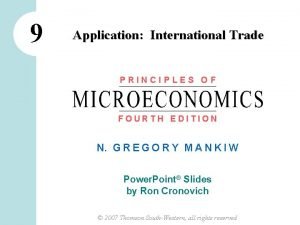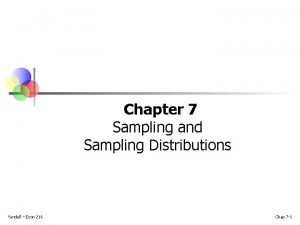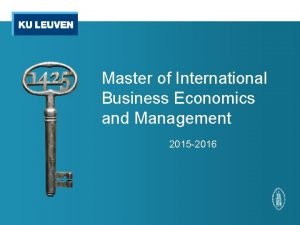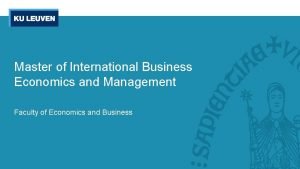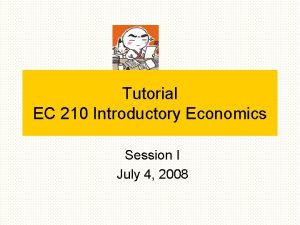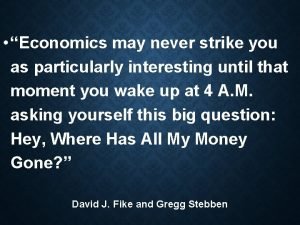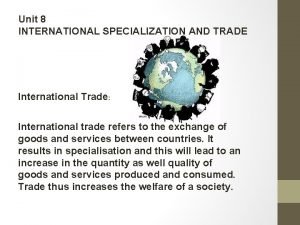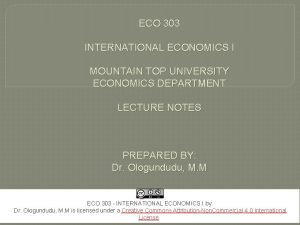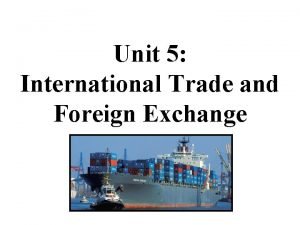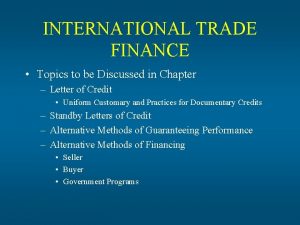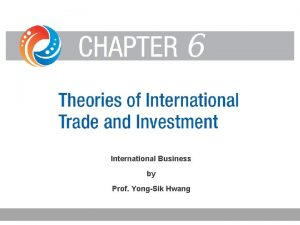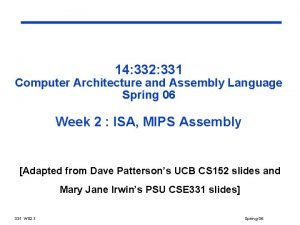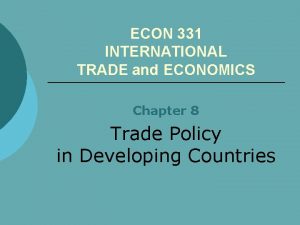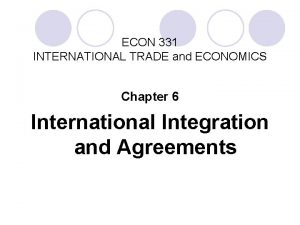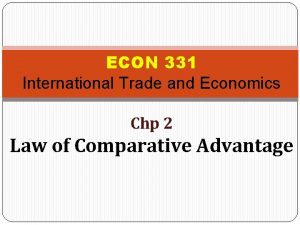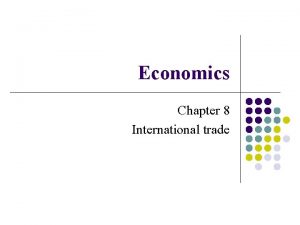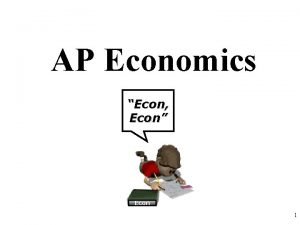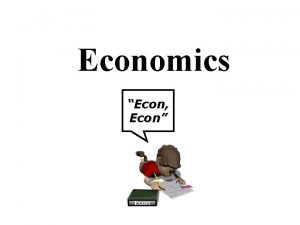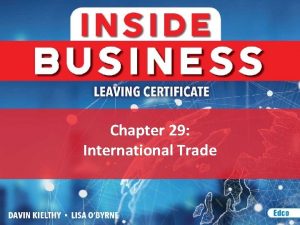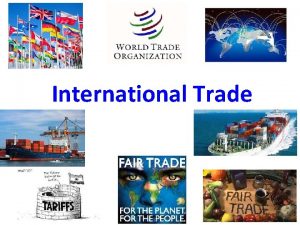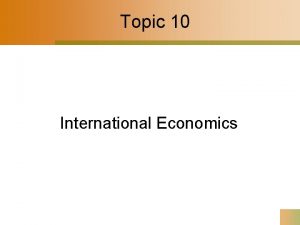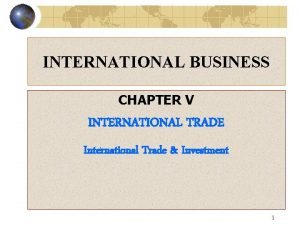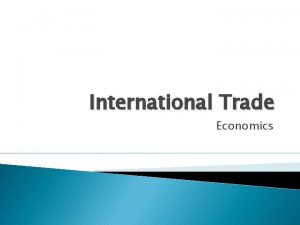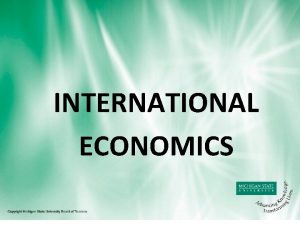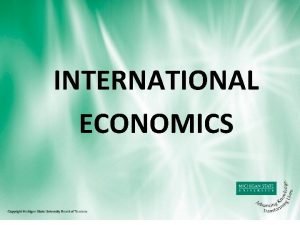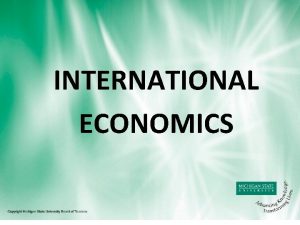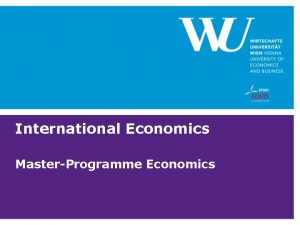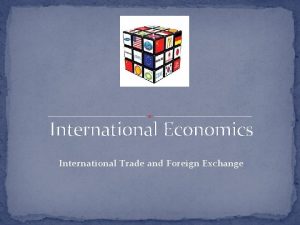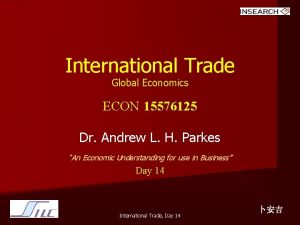ECON 331 International Trade and Economics Chapter 3




























- Slides: 28

ECON 331 International Trade and Economics Chapter 3 Factor Endowments Theory and Heckscher-Ohlin Model Salvatore: International Economics, 8 th Edition © 2004 John Wiley & Sons, Inc.

Factor-Proportions Theorem Developed by two swedish Economists Eli Heckscher and Bertil Ohlin in 1930 s Also called the Heckscher-Ohlin (H-O) Theory A country’s comparative advantage is based on its endowment of the factors of production Salvatore: International Economics, 8 th Edition © 2004 John Wiley & Sons, Inc.

Assumptions of H-O Theory 1. 2. 3. Two countries – (U. S. and UK) Two goods – (wheat and cloth) Production and consumption conducted under perfect competition A. Firms are price takers B. Prices of factors determined by supply and demand in each market Salvatore: International Economics, 8 th Edition © 2004 John Wiley & Sons, Inc.

Assumptions (Cont. ) 3. 4. 5. No barriers to trade (free trade) Consumers in both countries have equal tastes and preferences Both countries endowed with homogeneous factors of production and both used in production: Capital (K) and Labor (L) Salvatore: International Economics, 8 th Edition © 2004 John Wiley & Sons, Inc.

Assumptions (Cont. ) 7. 8. 9. Production Technology are same in both countries and produced under constant returns to scale. Capital and Labor can flow freely from one industry to the other domestically Labor and Capital cannot move freely between countries Salvatore: International Economics, 8 th Edition © 2004 John Wiley & Sons, Inc.

A new concept - Factor Intensity The input used in the production of a product intensively makes it «that» input intensive. If Labor is used intensively in the production of a product (ie wheat) it is said labor intensive product If capital is used intensively in its production, then it is capital intensive product a. If K/L ratio of cloth industry is higher than other industry (wheat) then the Cloth is sad to be Capital Intensive product Salvatore: International Economics, 8 th Edition © 2004 labor relative to capital – then b. If Wheat production uses more John Wiley & Sons, Inc. it would have lower K/L ratio and said to be Labor

Factor Intensity In a world of two goods (cloth and wheat) and two factors (labor and capital), cloth production is capital-intensive, if at any given wage-rental ratio the capital-labor ratio used in the production of cloth is greater than that used in the production of wheat: Kw/Lw < KC/ LC Example: If wheat production uses 80 workers and 20 units of Capital, while cloth production uses 20 workers and 20 units of Capital, then Salvatore: International Economics, 8 th Edition © 2004 John Wiley & Sons, Inc. cloth production is Capital-intensive and wheat

Factor Abundance Used to define the relatve factor endowment (ownership) of countries. If a country is relatively rich n Labor resources compared to capital, then it is said to be labor abundant economy wheras the other is Capital Abundant a) The K/L ratio is higher in U. K. than in US a) Important: It is the relative quantity of capital to labor that is key. Salvatore: International Economics, 8 th Edition © 2004 John Wiley & Sons, Inc.

Factor Abundance A country is capital-abundant compared to other country (US and UK) if and only if the ratio of the total amount of capital to labor is greater than that: (K/L)UK > (K*/L*)US Country with lower Capital- Labor ratio is said to be labor-abundant compared to other Salvatore: International Economics, 8 th Edition © 2004 John Wiley & Sons, Inc.

An Example Following table shows the labor and capital endowments of US and Canada. The table also shows the capital and labor requirements for the production of whisky and chocolate. Answer the following questions according to the table. USA Canada Whisky Chocolate Capital 240 160 4 4 Labor 240 120 4 2 a. What can you say for the factor abundance of each country? b. Which product is labor intensive and which product is Salvatore: intensive? International Economics, 8 th Edition © 2004 capital Show your calculations. John Wiley & Sons, Inc.

Solution Salvatore: International Economics, 8 th Edition © 2004 John Wiley & Sons, Inc.

The Factor-Proportions Theorem Assumed similar demand conditions in each country, supply of resources determines factor prices So Before trade Capital is less expensive in capital abundant country – i. e. U. K. Labor is less expensive in labor abundant country – i. e. US Salvatore: International Economics, 8 th Edition © 2004 John Wiley & Sons, Inc.

Figure 1 General Equilibrium Framework of the Heckscher-Ohlin Theory. Salvatore: International Economics, 8 th Edition © 2004 John Wiley & Sons, Inc.

Empirical tests of the H-O theory 4 - 14 The Leontief Paradox Test of the H-O theory done in 1951 Showed that pattern of trade did not fit the conclusions of the H-O theorem. Imports of the U. S. were found as capital intensive which they should have been labor intensive.

Empirical tests of the H-O theory: The Leontief Paradox The test assumed a two factor world which 4 - 15 Is the paradox real? required assumptions about what is capital and what is labor. The test assumed consistent technology between nations. However, technology varies so this assumption may have biased the test.

Empirical Tests of the H-O theory 4 - 16 Is the paradox real? The test assumed a two factor world which required assumptions about what is capital and what is labor. The test assumed consistent technology between nations. The test assumes perfect mobility between factors of production. In practice, some factors of production are specific to sectors of the economy. Sector specific factors alter the predictions of the H-O theory and require a different testing procedure.

Need for extending the H-O model 4 - 17 In the H-O model of trade, the pattern of trade is driven by relative factor abundance. Labor abundant countries export goods that are labor intensive in their production. Capital abundant countries export goods that are capital intensive in their production.

EXTENSIONS OF H-O MODEL- a. Factor Price Equalization trade is driven by relative factor abundance. What happens if exported commodities experience an increase in their price relative to their autarky situation. 4 - 18 In the H-O model of trade, the pattern of

EXTENSIONS OF H-O MODELa. Factor Price Equalization (Cont. ) International trade leads to complete equalization in the relative and absolute returns to homogeneous factors across countries. In the absence of trade, labor would earn less in labor abundant economy than in capital abundant economy, and capital would earn more in labor abundant economy and less in capital abundant economy Salvatore: International Economics, 8 th Edition © 2004 John Wiley & Sons, Inc.

a. Factor price equalization (Cont. ) increase in their price relative to the autarky situation. An increase in the relative price of a commodity raises the return of the factor used intensively in its production. Thus, the labor abundant country will see an increase in wages, but a fall in the return to capital while the capital abundant country will experience the opposite pattern of change. 4 - 20 Exported commodities experience an

Implications of Factor Price Equalisation capital abundant. Therefore, following the opening of trade the return to capital in the developed countries is expected to increase and wages are expected to fall. This pattern of change should worsen inequality in the developed countries. 4 - 21 Developed nations are expected to be

Implıcatıons of FPE 4 - 22 Developed nations are expected to be capital abundant. The change in inequality should be the opposite for the developing (and labor abundant) countries. The conclusion of worsened inequality in the developed world holds only if: The assumptions of the H-O theory holds. As will be seen, this may not be the case. The Stolper-Samuelson theorem is the only force driving changes in inequality.

FIGURE 2 Relative Factor–Price Equalization. Salvatore: International Economics, 8 th Edition © 2004 John Wiley & Sons, Inc.

Mechanism of Factor Price Equalisation An increase in the price of wheat relative to that of cloth, Pw/Pc , will: Raise the income of workers relative to that of capital owners, w/r. Raise the ratio of capital to labor, K/L, in both wheat and cloth production and thus raise the marginal product of labor in terms of both goods. Raise the purchasing power of workers and lower the purchasing power of capital owners, by raising real wages and lowering real interest in terms of both goods. Salvatore: International Economics, 8 th Edition © 2004 John Wiley & Sons, Inc.

Factor Price Equalisation: Convergence of Prices When Home and Foreign trade with each other, their relative prices converge. The relative price of wheat rises in US and declines in UK. In US, the rise in the relative price of wheat leads to a rise in the production of wheat and a decline in its relative consumption, so US becomes an exporter of wheat and an importer of cloth. Conversely, the decline in the relative price of wheat in UK leads it to become an importer of wheat and an exporter of cloth. Salvatore: International Economics, 8 th Edition © 2004 John Wiley & Sons, Inc.

Extensions of H-O Model: b. Rybczynski Theorem (effect): How do the outputs of the two goods change when the economy’s resource level change? If a factor of production (K or L) increases, then the supply of the good that uses this factor intensively increases and the supply of the other good decreases for any given commodity prices (The reverse is also true). Salvatore: International Economics, 8 th Edition © 2004 John Wiley & Sons, Inc.

b. Rybczynski Theorem (Cont. ): PPF shifts disproportionately along the axis of good that uses increased factor intensively, keeping relative prices unchanged Output of wheat, Qw Q 2 w Slope = -PC/Pw 2 Slope = -PC/Pw Q 1 1 w PP 1 PP 2 Q 2 C Q 1 C Output of International cloth, Salvatore: QC Economics, 8 th Edition © 2004 John Wiley & Sons, Inc.

Extensions of H-O Model: c. Stolper-Samuelson Theorem (effect): Factor Prices and Goods Prices If the relative price of a good increases, holding factor supplies constant, then the nominal and real return (in terms of both goods) to the factor used intensively in the production of that good increases, while the nominal and real return (in terms of both goods) to the other factor decreases (The reverse is also true). If (Pw/Pc ) increases, (w/r) will increase as well Salvatore: International Economics, 8 th Edition © 2004 John Wiley & Sons, Inc.
 Chapter 6 - theories of international trade and investment
Chapter 6 - theories of international trade and investment Chapter 9 application: international trade answers
Chapter 9 application: international trade answers Maastricht university school of business and economics
Maastricht university school of business and economics Trade diversion and trade creation
Trade diversion and trade creation Trade diversion and trade creation
Trade diversion and trade creation Which is the most enduring free trade area in the world?
Which is the most enduring free trade area in the world? Trade diversion and trade creation
Trade diversion and trade creation Tramp and liner shipping
Tramp and liner shipping Econ chapter 7
Econ chapter 7 Elements of mathematical economics
Elements of mathematical economics Ibfe manchester
Ibfe manchester Ku leuven international business economics and management
Ku leuven international business economics and management International business economics and management
International business economics and management What is trade off in economics
What is trade off in economics Wht does it mean
Wht does it mean Unit 8
Unit 8 Certificate in international trade and finance citf
Certificate in international trade and finance citf Kravis theory of availability
Kravis theory of availability International trade and foreign exchange
International trade and foreign exchange International trade and finance topics
International trade and finance topics Theories of international trade and investment
Theories of international trade and investment The trade in the trade-to-gdp ratio
The trade in the trade-to-gdp ratio Fair trade not free trade
Fair trade not free trade Ted talk atlantic slave trade
Ted talk atlantic slave trade Transportation planing
Transportation planing Ssis 331
Ssis 331 Uw cse 331
Uw cse 331 14:332:331
14:332:331 14:332:331
14:332:331
